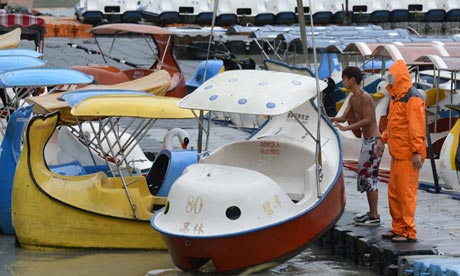Hong Kong braced for 'strongest storm on earth' as 180mph monster Super-Typhoon Usagi gains strength over the Pacific
The storm is set to roar between the Philippines and Taiwan before hammering the southern Chinese coast
Over the last day Super Typhoon Usagi, which is now the strongest storm to form on earth this year, has seen winds increase from 75mph on Tuesday to over 160 mph today. The cyclone is now classified now as a Super Typhoon and is considered the equivalent of a category 5 hurricane.
The storm, which is expected to maintain its current strength for at least the next 24 hours, is on course to dump 1000mm of rain (three times the annual London rainfall) on Taiwan over the next three days. The storm is set to roar between the Philippines and Taiwan before hammering the southern Chinese coast, and possibly Hong Kong, later in the weekend.
Experts have said that due to the lack of 'hurricane hunter' aircraft in the Pacific they can't accurately measure how strong the storm is, and that it may be even stronger.
According to Quartz one satellite-based estimate ranks the storm as the most powerful on the planet since 1984, having a minimum central pressure of 882 millibars.
Typhoon Usagi will first batter coastal Taiwan bringing with it damaging winds, a significant storm surge and heavy and persistent rain, before heading towards Hong Kong.
Peak winds are at that time predicted to have weakened to around 100mph.
Read More Here
******************************************************************************
Philippines evacuates coastal villages ahead of typhoon Usagi
Strongest storm to hit western Pacific this year set to strike Philippines and Taiwan on way to Hong Kong and China
- theguardian.com, Friday 20 September 2013 03.55 EDT

Workers remove tourist boats in the south-east Philippines as typhoon Usagi approaches. Photograph: Sam Yeh/AFP/Getty Images
With winds of 127 mph, typhoon Usagi, the strongest storm to hit the western Pacific this year, was moving north-west between the Philippines and Taiwan and headed for Hong Kong and south China.
China's Xinhua news agency said preparations were being made for an "emergency response" in southern coastal areas.
Storm alerts have been raised on the rice and coconut-growing island of Batanes and 15 provinces on the main Philippines island of Luzon, the weather bureau said.
"Our people there know the drill, but we have also issued warnings to take safety precautions," the budget secretary, Florencio Abad, said. "We're praying it doesn't create death and destruction."
A typhoon hit Batanes in 1987, destroying all roads as the water level surged as high as seven metres. "All our coconut trees broke in half," Abad said.
Power and communications in the area have been cut off for safety reasons and hospitals were put on alert as disaster agencies stocked up on food and water. Troops were also put on standby.
Read More Here
******************************************************************************
Monstrous super typhoon Usagi holding its own, Hong Kong braces for possible impact

This image was taken by the Japan Meteorological Agency’s MTSAT-2 satellite at 0730Z on September 20, 2013. (NOAA)
Super typhoon Usagi, 2013′s strongest storm on the planet, may have peaked in intensity, but remains an extremely dangerous cyclone as it continues on a collision course with southern Taiwan and, likely, Hong Kong.
The Joint Typhoon Warning Center says Osagi’s maximum sustained winds are 150 mph, the equivalent of a category 4 hurricane. That’s down from at least 160 mph Thursday (category 5 level). But this is a mammoth storm, tropical storm force winds span 275 miles across it.
On Thursday evening, a satellite-based estimate of its minimum pressure was an astonishingly low 882 mb, which would have made it the deepest and most intense storm to exist on Earth since 1984 (tied with hurricane Wilma in 2005).
Look at this incredible high resolution satellite image of the storm from Thursday afternoon, revealing the textbook traits of a flawless cyclone:

Usagi infrared satellite view 12:33 p.m. ET Thursday (Colorado State University)
You see the cloud-free, distinct eye which is surrounded by tall thunderstorms on all sides.Due to a re-arrangement of its internal structure since that time, known as an eye-wall replacement cycle, Usagi has lost some steam and its satellite presentation – while impressive – is less than perfect.

Usagi infrared satellite view 1:14 p.m. ET Friday (NOAA)
What’s next for Usagi?
The Joint Typhoon Warning Center predicts additional weakening as Usagi’s circulation is disrupted by Taiwan. Usagi will batter Taiwan’s south and east coast with damaging winds, torrential range, massive waves, and a dangerous storm surge today into Saturday. The storm’s rain bands have already begun to lash coastal areas.
Link: Animated Taiwan radar loop
Usagi is then expected to cross the South China Sea, but further weakening is forecast.
“THE SYSTEM IS UNLIKELY TO RE-INTENSIFY OVER THE SOUTH CHINA SEA DUE TO LAND INTERACTION AND DECREASING OCEAN HEAT CONTENT,” says the Joint Typhoon Warning Center.
Read More Here
******************************************************************************











No comments:
Post a Comment
Hello and thank you for visiting my blog. Please share your thoughts and leave a comment :)